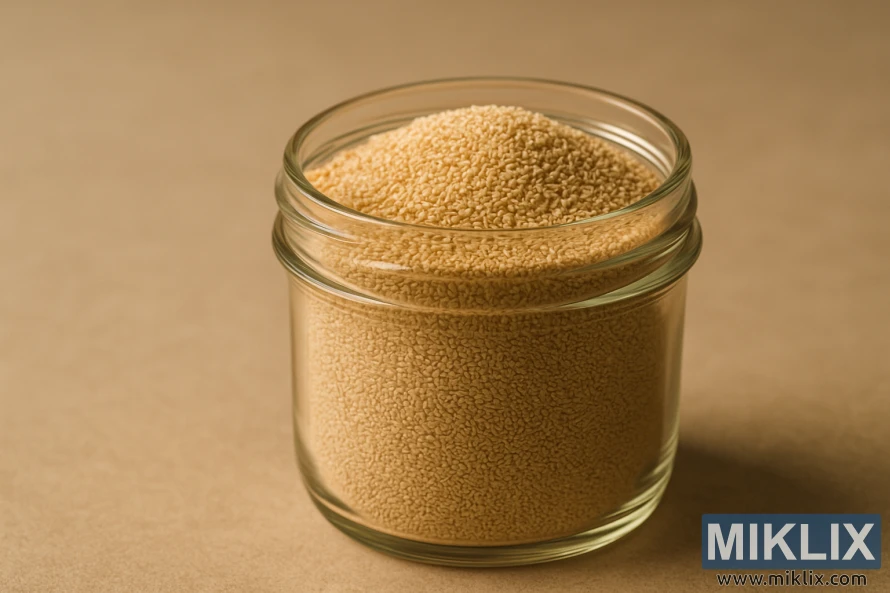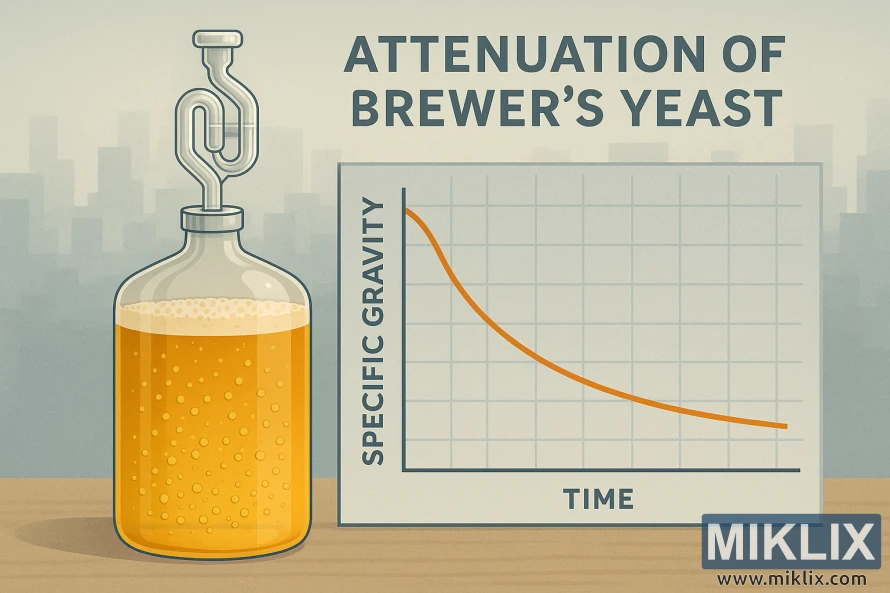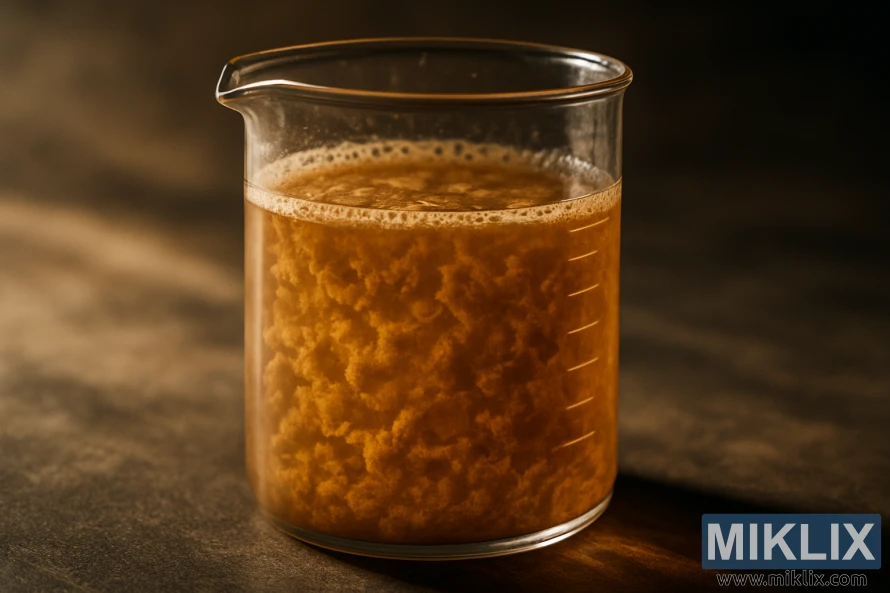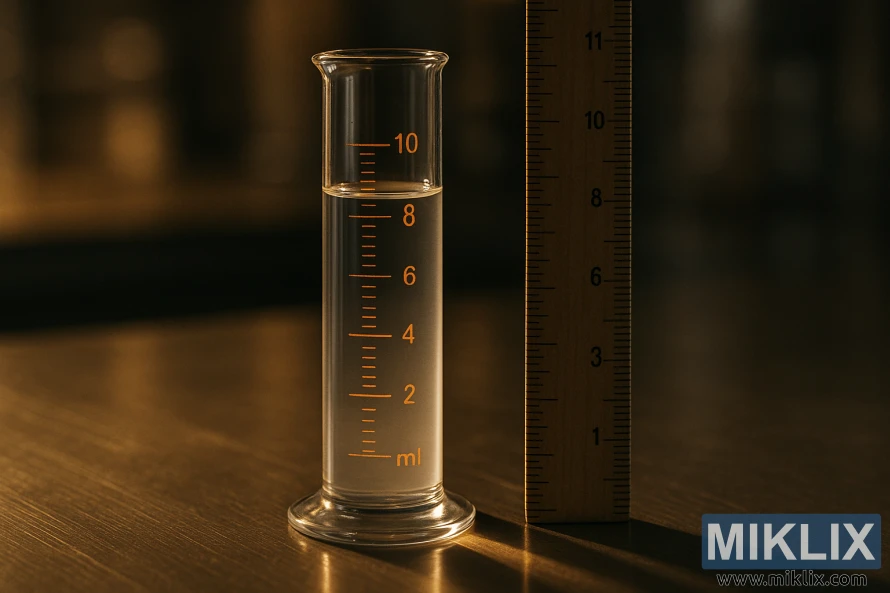Fermenting Beer with Lallemand LalBrew BRY-97 Yeast
Published: September 17, 2025 at 9:16:04 PM UTC
Lallemand LalBrew BRY-97 is a dry Saccharomyces cerevisiae strain, marketed by Lallemand. It was chosen from the Siebel Institute Culture Collection for clean, top-fermented ales. This BRY-97 review covers the strain's background, typical performance, and best handling practices for both homebrew and commercial batches. This yeast is seen as an American West Coast ale yeast. It has a neutral to lightly estery aroma, high flocculation, and high attenuation. It also exhibits β-glucosidase activity, which can enhance hop biotransformation, making it ideal for hop-forward styles.

This article will explore the strain's origin, fermentation performance, ideal temperatures, and rehydration and seeding rates. It will also discuss conditioning and packaging options. Practical notes include an attenuation range of 78–84%, vigorous fermentation finishing in roughly four days above 17 °C (63 °F), alcohol tolerance near 13% ABV, and recommended seeding strategies for consistent results when fermenting beer with BRY-97.
Key Takeaways
- Lallemand LalBrew BRY-97 Yeast is a dry Saccharomyces cerevisiae selected for clean American-style ales.
- Expect neutral to light esters, high flocculation, and 78–84% attenuation in most worts.
- Fermentation is often vigorous and can complete in about four days at temperatures above 17 °C (63 °F).
- β-glucosidase activity supports hop biotransformation, useful for IPA and NEIPA styles.
- Suitable for both homebrewers and commercial producers; plan seeding rates and packaging to match batch size.
Overview of Lallemand LalBrew BRY-97 Yeast
LalBrew BRY-97 is a dry ale yeast, perfect for clean, crisp American-style beers. It's a Siebel Institute selection, available for both craft and commercial brewers through Lallemand.
The strain, Saccharomyces cerevisiae BRY-97, produces neutral to light esters. This makes it ideal for beers where hop character is the main focus.
- Neutral flavor with restrained fruity notes
- High flocculation for faster clarification
- High attenuation to leave beers dry and bright
Manufacturer sources highlight β-glucosidase expression in the yeast. This enzyme enhances hop biotransformation during fermentation. It unlocks hop-derived aromas in late and dry hopping.
Packaging and market positioning target brewers looking for reliable, high-performance dry yeast. LalBrew BRY-97 is seen as a versatile option for IPAs, pale ales, and other West Coast-style brews.
Why Choose an American West Coast Ale Yeast
American West Coast ale yeast benefits are evident when brewers aim for a clean canvas for hops and malt. These strains highlight clarity in bitterness and hop aroma, avoiding strong fruity esters. They are perfect for hop-forward beers like American Pale Ale and American IPA.
The BRY-97 flavor profile aligns with this approach. It offers a neutral fermentation with light esters, ensuring the hop character remains dominant. Brewers seeking a consistent, predictable finish will appreciate how this yeast preserves delicate hop oils and crisp malt notes.
West Coast ale fermentation is known for being brisk and attenuative, resulting in a dry finish that accentuates perceived bitterness. This fermentation style is suitable for a wide range of beers, from Imperial IPA to cream ale. It also scales well for stronger beers like barleywine or Russian Imperial Stout, where higher alcohol tolerance is required.
- Shows hop aroma and bitterness clearly in dry, crisp beers
- Offers versatile use across pale ales, ambers, and stronger ales
- Produces predictable attenuation and clean fermentation profiles
When choosing a strain for a hop-forward recipe, consider how American West Coast ale yeast benefits will interact with your hop schedule and malt bill. Pairing these choices with the BRY-97 flavor profile creates a focused beer where ingredients speak plainly and powerfully.
Fermentation Performance and Attenuation
Lallemand LalBrew BRY-97 exhibits medium–high attenuation in typical ales. The manufacturer suggests its attenuation is around 78–84%. This results in beers that are drier but retain enough body for a pleasant mouthfeel.
The fermentation rate of BRY-97 is both fast to start and vigorous once it begins. When pitched correctly and fermented above 17 °C (63 °F), it can finish in as little as four days. The speed of fermentation depends on several factors, including pitching rate, oxygenation, wort gravity, and nutrient levels.
Alcohol tolerance of BRY-97 is high, reaching up to roughly 13% ABV. This makes it suitable for standard ales and many higher-gravity beers, such as Imperial IPA and Barleywine. Adequate pitching and nutrition are essential for achieving this tolerance.
- Expected attenuation: roughly 78–84% under typical homebrew conditions.
- Typical fermentation duration: rapid lag removal and active fermentation within 24–72 hours under warm, well-oxygenated conditions.
- Alcohol ceiling: around 13% ABV with strong nutrition and proper cell counts.
Performance caveats are important. The degree of attenuation and fermentation rate of BRY-97 can vary. Factors such as inoculation density, oxygenation, wort gravity, and temperature control play a role. Lower pitching or poor oxygenation can slow fermentation and reduce apparent attenuation.
For higher-gravity projects, it's essential to increase pitching rates and oxygenate generously. Providing yeast nutrients is also key to meet the alcohol tolerance of BRY-97. These steps help maintain fermentation vigor and achieve target attenuation while minimizing off-flavors.

Ideal Fermentation Temperatures and Timelines
For optimal results, set the BRY-97 fermentation temperature between 15–22 °C (59–72 °F). A cooler temperature, around 15 °C, results in a cleaner ester profile and slower fermentation. On the other hand, warmer temperatures above 17 °C enhance fermentation speed and fruity ester production.
When pitching at the warmer end of the range, expect a rapid onset. At 20–22 °C, primary fermentation can show strong activity within 24–48 hours. Under these conditions, full primary fermentation typically completes in about four days.
For conditioning, follow the LalBrew BRY-97 timeline. After primary fermentation, allow additional time for clearing and maturation. Low-gravity ales may condition in a week. In contrast, high-gravity beers require longer conditioning to fully attenuate and smooth out flavors.
- Temperature: 15–22 °C (59–72 °F)
- Fast primary at warmer end: ~4 days
- Cool, clean profile near 15 °C: slower finish
Adjust schedules based on gravity readings. If attenuation stalls, slightly increasing the temperature can help. Remember, temperature control impacts ester production, attenuation, and flocculation behavior.
Plan your schedule according to desired flavor outcomes. For a crisp West Coast ale, target the lower-to-mid range of ideal ale fermentation temps. For more pronounced esters and faster turnaround, aim higher in the BRY-97 fermentation temperature window and monitor the LalBrew BRY-97 timeline closely.
Yeast Handling and Rehydration Best Practices
Proper LalBrew yeast handling begins with the package. Store dry yeast in a cool, dry place until use. Adhere to the manufacturer's date code to maintain viability.
For BRY-97 rehydration, use sterile water at the recommended temperature range. Slow temperature shifts reduce stress. This promotes fast activity after pitching BRY-97 into wort.
- Sanitation: sanitize all tools and containers used for rehydration.
- Water quality: use chlorine-free, room-temperature water for best results.
- Timing: rehydrate for the duration advised by Lallemand before inoculation.
LalBrew yeast handling also involves inoculation density. Aim for the manufacturer guideline of about 50–100 g per hL for many ales. Increase the seeding rate for higher gravity worts or when skipping a starter.
When pitching BRY-97, oxygenation is key. Provide adequate dissolved oxygen or a short pure oxygen pulse at pitching. This supports robust biomass growth, reducing lag time and off-flavors.
- Adjust pitch rate based on gravity and fermentation goals.
- Consider nutrient additions for high gravity worts to prevent nutrient stress.
- Monitor fermentation temperature closely after pitching BRY-97 to keep the profile within target ranges.
Simple, consistent technique in LalBrew yeast handling yields predictable fermentations. Clean technique, correct rehydration, and proper oxygenation set BRY-97 up to perform and finish cleanly.
Flocculation, Clarification, and Conditioning
LalBrew BRY-97 is renowned for its strong flocculation. Yeast cells clump and settle, resulting in a clearer beer without the need for long filtration. This characteristic allows brewers to achieve a bright beer more quickly, provided fermentation has proceeded well.
To enhance LalBrew clarification, simple actions can make a significant difference. Cold crashing for two to five days encourages yeast to settle. Employing fining agents like isinglass or silica gel can further expedite clearing for both kegs and bottles.
Timing is critical due to the yeast's tendency to flocculate heavily. If yeast flocs prematurely, it can lead to higher final gravity. Ensuring proper pitching rates and maintaining healthy nutrient levels can mitigate the risk of stuck fermentation.
Conditioning BRY-97 after primary fermentation allows the yeast to refine the beer. Additional time at moderate cool temperatures is essential for attenuating residual sugars and smoothing out yeast-driven flavors. This step is critical for high-gravity ales.
- Promote settling: chill and rest without disturbance.
- Encourage complete attenuation: ensure yeast health and adequate conditioning BRY-97 time.
- Clarify: use LalBrew clarification tools like finings when clarity is a priority.
Making small adjustments to handling can lead to cleaner results. Effective management of BRY-97 flocculation and adherence to proper LalBrew clarification practices can significantly reduce haze. This ensures the beer reaches its intended profile during the conditioning BRY-97 phase.

Hop Biotransformation and Aroma Enhancement
Yeast transforms hop compounds into new aromatic molecules during fermentation. BRY-97 hop biotransformation is the enzymatic process that releases bound hop terpenes from glycosides. This action uncovers floral, fruity, or citrus notes that were hidden in the wort.
The enzyme β-glucosidase BRY-97, found in some LalBrew strains, plays a critical role. It breaks down sugar-bound aroma precursors, releasing volatile terpenes into the beer. Brewers notice a more pronounced hop character when they fine-tune fermentation timing and dry hopping to support this process.
Practical methods for boosting hop aroma include late or post-fermentation dry hopping. Using hops with high glycoside content, like certain Citra, Mosaic, or Nelson Sauvin lots, also helps. Gentle yeast handling and avoiding aggressive oxygenation are essential to preserve enzymatic function and aroma.
Keep in mind that biotransformation outcomes depend on strain, hop variety, and timing. Trial batches are key to understanding how β-glucosidase BRY-97 interacts with specific hop combinations. Adjusting hopping schedules, contact times, and temperatures often leads to significant improvements in hop aroma.
- Consider late dry hop additions to maximize enzymatic contact.
- Use hop varieties known for rich glycoside profiles.
- Maintain clean yeast handling to protect β-glucosidase BRY-97 activity.
Nutrition and Wort Preparation for Optimal Fermentation
Optimal BRY-97 wort preparation hinges on balanced malt bills and a clear plan for nutrients. Ensure adequate free amino nitrogen (FAN) and essential minerals to support yeast nutrition BRY-97 during early growth.
Pitch at the correct inoculation density. Underpitching stresses the culture, slows fermentation, and increases the risk of off-flavors. Match cell counts to gravity and temperature for steady kinetics.
- Measure FAN and adjust with yeast nutrients when values are low.
- Test hardness and add calcium or magnesium if needed to boost yeast uptake of amino acids.
- For high-gravity runs, consider step-feeding of sugars and staged nutrient additions.
Oxygenation for BRY-97 at pitching is critical. Provide sufficient dissolved oxygen to enable strong cell replication and healthy ester profiles. Use aeration or pure O2 depending on batch size and starting gravity.
When pushing toward the strain’s alcohol tolerance, increase oxygenation for BRY-97 and follow a nutrient schedule. Staggered additions reduce stress and help prevent stuck fermentations.
Monitor gravity and fermentation kinetics daily. If attenuation stalls, evaluate FAN, pH, and oxygen history before adding more yeast or nutrients.
Simple practices make a big difference: fresh yeast, clean handling, correct pitching rate, and timely oxygenation for BRY-97 all improve attenuation and consistency.
Common Beer Styles Brewed with BRY-97
BRY-97 shines in American and British ales, thanks to its neutral flavor and strong attenuation. It's perfect for brewing American Pale Ale, American IPA, Imperial IPA, American Amber, American Brown, and American Stout. This yeast allows the hops and malt to shine through, creating a clean beer character.
It's ideal for both sessionable and high-ABV beers. For a dry finish, try Cream Ale, American Wheat, or Kölsch. On the other hand, American Barleywine, Russian Imperial Stout, and Strong Scotch Ale benefit from its alcohol tolerance and attenuation. This allows for higher gravities without the esters dominating the flavor.
The manufacturer suggests using BRY-97 for Scotch Ale, Oatmeal Stout, Belgian Blonde, Dusseldorf Altbier, Extra Special Bitter, and Irish Red Ale. These styles appreciate the yeast's clean fermentation and subtle mouthfeel contribution.
- Hop-forward: American IPA, Session IPA, Imperial IPA — yeast supports hop biotransformation and clarity.
- Malt-forward: Scottish Ale, Scotch Ale, Old Ale — yeast leaves a balanced malt backbone with restrained esters.
- Hybrid and specialty: Roggen/Rye, Blonde Ale, Kölsch — yeast handles rye spice and delicate malt characters.
When selecting BRY-97 for brewing, consider the desired dryness and hop presence. Its high attenuation (78–84%) is great for drier finishes. Opt for recipes where a clean yeast profile enhances hop aroma or malt complexity, not masking them.
For those scaling up, BRY-97's versatility means fewer strain swaps. Plan your water, mash, and hopping to match the style. Let the yeast deliver consistent, clean fermentation across batches.
Troubleshooting Fermentation Issues
When fermentation slows or stalls, common causes include underpitching, low oxygen at inoculation, weak wort nutrition, or too-cold fermentation temperatures. Early recognition helps prevent a prolonged stuck fermentation BRY-97 and limits stress on the yeast.
Follow a simple checklist to troubleshoot. Check current gravity against expected values and confirm fermentation temperature. If oxygenation was marginal and the beer is in early active stages, a careful reoxygenation can revive yeast activity without promoting oxidation.
If yeast shows signs of stress from rehydration or handling, consider adding yeast nutrient or a small, healthy starter of a compatible ale strain. Repitching with fresh Lallemand culture or a commercial ale yeast can recover a stubborn stuck fermentation BRY-97 after 48–72 hours of little to no change.
Off-flavors often stem from stress during fermentation. Proper pitching, correct temperature control, and good wort nutrition reduce the risk of off-flavors BRY-97. Lallemand notes that BRY-97 does not produce malodors when handled correctly, so focus on preventive steps to preserve clean ester and hop profiles.
- Verify oxygen and pitching rates before fermentation starts.
- Keep temperature within the yeast’s recommended range; raise it gently if fermentation stalls.
- Add yeast nutrient early if the wort is high-gravity or low in free amino nitrogen.
- Consider repitching after prolonged inactivity with a healthy starter culture.
Early flocculation can cause apparent slowdowns as yeast drop out of suspension before full attenuation. Avoid premature flocculation by ensuring adequate pitch rate and nutrition. Use moderate temperature control to keep cells active until the target gravity is reached.
Document corrections and outcomes for each batch. This practice improves your BRY-97 troubleshooting skills and helps you fine-tune processes to minimize stuck fermentation BRY-97 and reduce the chance of off-flavors BRY-97 in future brews.
Batch Planning: Seeding Rates and Scale-Up Strategies
When planning your seeding, aim for a specific target. Lallemand suggests a BRY-97 seeding rate of 50–100 g/hL for most ales. Adjust this range based on wort gravity, target attenuation, and desired fermentation speed.
For beers with higher gravity, opt for the upper end of the BRY-97 seeding rate. A higher LalBrew pitch rate accelerates fermentation, shortens time-to-finish, and often reduces ester creation. Lower pitch rates, on the other hand, prolong fermentation and can increase fruity esters.
- Calculate grams per batch by converting batch volume to hectoliters.
- Factor in extra yeast for repitching or unexpected losses.
- Record actual LalBrew pitch rate used for repeatable results.
Scaling up BRY-97 from homebrew to production requires using multiple sachets or 500 g bulk packs. Building a yeast starter or controlled propagation is often necessary for liquid cultures or very large batches.
When scaling up BRY-97, consider your fermentation targets. For commercial runs, choose propagation with measured cell counts. This preserves yeast health and ensures predictable attenuation.
- Estimate required yeast: batch volume × desired BRY-97 seeding rate.
- Decide between sachets, bulk packs, or starter propagation.
- Order bulk quantities to reduce cost per gram and maintain supply for repitching.
Variables like wort gravity, fermentation temperature, and desired flavor profile influence the LalBrew pitch rate decision. Higher pitch rates favor clean, fast fermentations. Lower rates can enhance complexity but require tighter control.
Keep detailed records of seeding rates, fermentation profiles, and outcomes. This data makes future scale-up BRY-97 runs predictable and helps optimize LalBrew pitch rate for each recipe and production scale.

Impact on Hop Bitterness and Perceived Bitterness
Lallemand LalBrew BRY-97 can alter how hops are perceived in the final beer. Its high flocculation rate causes yeast and hop particles to settle faster. This can decrease measured bitterness and change the beer's balance.
Brewers often observe a subtle gap between lab IBU readings and the beer's actual bitterness. The perceived bitterness of BRY-97 can be slightly lower due to early yeast flocculation. This pulls out polyphenols and suspended hop material.
On the other hand, enzymatic activity within yeast cells can have the opposite effect. β-glucosidase-driven hop biotransformation releases bound aromatics. This can enhance hop flavor and scent, potentially increasing hop intensity even if measured bitterness is lower.
- Adjust late hopping or dry-hop rates to compensate if you want more bite.
- Time dry hops to maximize biotransformation without adding haze.
- Monitor yeast effect on IBU when scaling recipes to larger batches.
When planning recipes, consider the small shifts in IBU perception. BRY-97 hop bitterness and perceived bitterness BRY-97 both depend on hopping schedule, yeast handling, and contact time with trub.
Utilizing dry hopping to harness biotransformation allows for intensifying aroma and flavor without increasing measured IBU. Track the yeast effect on IBU in pilot batches before scaling up. This helps fine-tune the balance you aim for.
Laboratory and Commercial Use Cases
Many commercial breweries opt for BRY-97 for its clean, neutral fermentation profile. This yeast is known for its predictable attenuation and high flocculation. These traits make it ideal for core beers and flagship ales.
In pilot brewhouses and sensory labs, BRY-97 is preferred for strain comparison and hop biotransformation trials. Its enzymatic profile, including β-glucosidase activity, aids in testing aroma release from modern hops.
Bulk packaging in sizes like 500 g is beneficial for repeated production runs, reducing costs for large-scale operations. This packaging model indicates BRY-97's readiness for adoption across various SKUs in breweries.
Practical lab workflows utilize BRY-97 to model pitching rates and nutrient regimes before scaling up. Small-scale trials show consistent attenuation near 78–84% when rehydration and oxygenation are controlled.
- Repeatable flavor profiles for core beers.
- Efficient pilot testing of hop-forward recipes.
- Bulk supply options that suit contract and production breweries.
Commercial teams report steady performance when handling and rehydration follow manufacturer guidelines. This consistency supports broader adoption of BRY-97 in seasonal and year-round lines.
Laboratory yeast BRY-97 data helps brewers set pitching rates, oxygen targets, and nutrient additions. Clear benchmarks reduce risk during scale-up from lab to full production.
For operations assessing yeast options, BRY-97 commercial use offers a reliable baseline strain. It aligns with product development needs, quality control practices, and the economics of larger-scale brewing.
Conclusion
Lallemand LalBrew BRY-97 stands out as a dependable, versatile ale yeast. It offers a neutral to light ester profile, high attenuation (78–84%), and strong flocculation. Fermentations finish quickly, often in about four days above 17 °C. Its β-glucosidase activity enhances hop aroma and flavor in hop-forward American ales.
For practical use, follow proven handling: rehydrate properly, pitch at recommended rates (50–100 g/hL), oxygenate wort, and ensure adequate nutrition. These steps help the culture reach its ABV tolerance near 13% and realize the full attenuation range. In short, LalBrew BRY-97 is a dependable choice when consistency and clean attenuation matter.
From a commercial perspective, bulk 500 g packs and tiered pricing make BRY-97 attractive for small and medium breweries. Plan supply and storage to maintain viability and batch-to-batch consistency. When selecting the best uses BRY-97, favor hop-forward American ales but don’t shy away from pale malty styles or hybrid beers where clean attenuation and biotransformation matter.
Match temperature and pitching strategy to your flavor targets: cooler ferments for a cleaner profile, warmer for a quicker finish and slightly fuller ester expression. Use the strain’s biotransformation when designing late hop additions and dry-hop schedules to maximize aroma impact in the finished beer. This BRY-97 conclusion ties performance, handling, and commercial factors into clear guidance for brewers.
Further Reading
If you enjoyed this post, you may also like these suggestions:
- Fermenting Beer with Bulldog B5 American West Yeast
- Fermenting Beer with Fermentis SafLager W-34/70 Yeast
- Fermenting Beer with Fermentis SafBrew DA-16 Yeast
